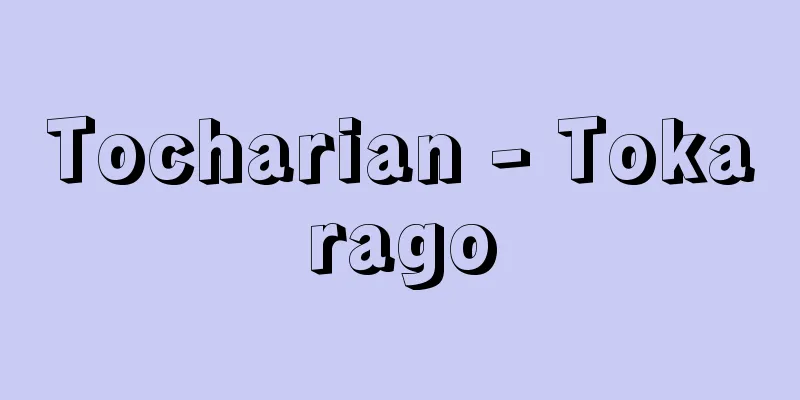Tocharian - Tokarago

|
This language is known from documents from the 7th and 8th centuries discovered in the desert of the Tarim Basin, which is located in East Turkistan, which is now part of China, and where the Silk Road passes through, in the late 19th and early 20th centuries. In 1908, it was deciphered by German scholars Emil Sieg and Wilhelm Siegling, and found to be an Indo-European language. The existing documents are written in Brahmi script, and are mainly translations of Sanskrit Buddhist scriptures, but also include passage permits for caravans. Two dialects, A and B, are distinguished, the former being called the "Turfan dialect" and the latter the "Kucha dialect." It is unknown which ethnic group spoke this language, which advanced into this region early on and disappeared when absorbed into the Turkic Uighur language, but it is completely different from the Iranian Tocharians, and therefore the name Tocharian is not necessarily appropriate. Although this language is located the furthest east among the Indo-European languages, it does not belong to the "Satemic group" which includes Indian, Iranian, and Slavic languages, but to the "Centmic group" which includes Greek, Latin, and Germanic languages, and is located to the west. Its linguistic characteristics include no distinction between voiced and unvoiced, or aspirated and unaspirated consonants, but instead a well-developed palatalization, nine distinct cases for nouns, and agglutinative-like inflections, showing unique developments. However, it has well preserved the ancient aspects of Indo-European languages, such as the verb conjugation system. Along with Hittite, it has been considered important in recent years as a new Indo-European language. [Katsumi Matsumoto] Source: Shogakukan Encyclopedia Nipponica About Encyclopedia Nipponica Information | Legend |
|
19世紀末から20世紀初頭にかけて、現在中国領に属する東トルキスタン、シルク・ロードが通ずるタリム盆地の砂漠から発見された7~8世紀の文献によって知られる言語。1908年、ドイツの学者ジークEmil SiegおよびジークリングWilhelm Sieglingによって解読され、印欧語に属する一言語であることが判明した。現存する資料は、ブラーフミー文字で書かれ、主としてサンスクリット語の仏典の翻訳であるが、なかには隊商のための通行許可書なども含まれている。A・B二つの方言が区別され、最近は前者を「トゥルファン方言」、後者を「クチャ方言」とも称する。早くからこの地方に進出した、チュルク系ウイグル語に吸収されて消滅したこの言語を話していた民族については不詳だが、イラン系トカラ人とはまったく別で、したがってトカラ語という名称はかならずしも適切な命名とはいえない。この言語は印欧語のなかでもっとも東方に位置するにもかかわらず、インド語、イラン語、スラブ語などを含む「サテム群」ではなく、ギリシア語、ラテン語、ゲルマン語など西方の「ケントゥム群」に属する。言語的特徴としては、子音に有声・無声、有気・無気の区別がなく、そのかわりに口蓋(こうがい)化が発達し、名詞は九つの格を区別し、語尾変化が膠着(こうちゃく)語的であるなど、特異な発達を示す反面、動詞の活用組織などに印欧語の古い相をよく保存している。ヒッタイト語とともに印欧語系の新たな言語として近年重要視されている。 [松本克己] 出典 小学館 日本大百科全書(ニッポニカ)日本大百科全書(ニッポニカ)について 情報 | 凡例 |
<<: Tokara Islands - Kararetto
Recommend
organisation
…It is a young, soft, vascular connective tissue ...
Dvinsk
…Population: 129,000 (1991). German name: Dünabur...
Vacation - Holiday
〘Noun〙① (formerly also called "kyuuka" (...
Masaki - Masaki
An evergreen shrub of the Celastraceae family (AP...
Bullionism - juukinshugi (English spelling)
Mercantilism was dominant in European countries f...
Anglican Communion
…In the narrow sense, it refers to the Church of ...
Vitigis
…Theodahad promised to abdicate on the condition ...
Innate Releasing Mechanism
Sometimes abbreviated as IRM. It is considered the...
Grigorii Andreevich Gershuni
1870‐1908 Russian revolutionary. Leader of the Soc...
Pinched nerve - pinched nerve
A type of armrest . A device that is placed in fro...
Oyuya - Oyuya
〘 noun 〙 A large bathhouse. A large public bathhou...
Cold Zone - Cold Zone
The coldest region on Earth. It is the region on ...
Gordon, AL (English spelling) GordonAL
…Private schools also follow the state system for...
Courthorpe, William John
Born 17 July 1842, South Malling, Sussex [Died] Ap...
Plasma membrane
...The plasma membrane is the outermost boundary ...









